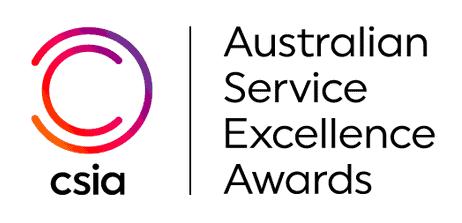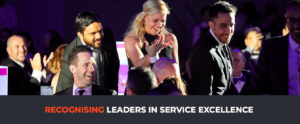As Certified Practitioners with Customer Service Institute Australia (CSIA) we get the privilege each year to participate on the judging panel for the Australian Service Excellence Awards.
We have 8 insights from our experience that we hope will help you have best in class service. There are 3 new ways of working and 5 proven methods that deliver exceptional customer experience and in Australia are not currently consistently put place.
Some new ways of working that are consistently delivering large business benefits that finalists shared:
1. Harnessing the value in public customer feedback
We all know that having happy clients is a key element to a successful business. This year was the first year I observed public customer satisfaction surveys consistently being a driver of business performance and growth.
While there is often reluctance to expose the organisation to public comment, the best organisations are embracing it. The examples included via third party websites such as TrustPilot or google reviews. This was part of their customer satisfaction survey. This enables potential customers to see feedback from your existing customer base and how you responded to it.
There is a clear link between public customer feedback and growth and revenue during judging so, what are the reasons behind this:
- Showcase your customer focus and performance publicly using the genuine voice of your customers as your best marketing tool.
- Publicly address dissatisfied customers issues showing how you care and take action.
- Use the feedback to optimise service as a channel not a Voice of the Customer program.
- Publicly demonstrate to your employees that customer service is a focus and that their actions will be public. This creates team alignment around a company purpose motivating the right behaviours and actions.
The feedback of your existing customers is likely better than any marketing campaign or employee engagement campaign you could run! And the rich data is a source of ongoing improvement. A great win-win.
2. CSR for the CSR
Re-imagine Corporate Social Responsibility (CSR) programs that have an added benefit of improving knowledge and the empathy of your team to drive superior service and employee engagement.
It may be hard to empathise in a situation you have no experience with. We spoke with one finalist who supports customers experiencing financial hardship. They found their customer service representatives were able to relate better, provide more effective service and empathise due to their volunteer work with under privileged in their community. They volunteered at a local soup kitchen having a direct impact on their customers. As a result team conversations changed in the office with team members discussing the people they helped and how these people are impacted by their companies services. It made customers relatable and with this empathy, staff were able to provide more relevant assistance, made better decisions, delivered more effective services and were able to design viable future services.
I am confident if your organisation found a CSR initiative that was local and aligned to your customers challenges then it would bring significant ongoing benefit to society, your customers and your business.
3. Embracing a marketing-led service
One finalist in the awards is breaking every customer service rule but amazingly getting incredible satisfaction levels, rising revenue, and delivering at an offshore cost to serve in Australia.
How? They are using marketing driven customer service. They started with a brand/vision and then they linked everything they did to it (not to best practices but rather developed practices to enable their brand experience).
This provides a unique and relevant customer experience where every connection with a customer is branded. This has driven the way they employ staff, the kinds of services they have and even their work environment. The result is a very specific service experience (not for everyone). The speed of change is unprecedented as decision making becomes easy. I love they break conventional wisdom and are inventing new ways of doing things.
As always, our brains are looking for the opportunities and we found a couple of great opportunities we thought we should share too! These are the consistent opportunities, all finalists have gaps which provides lessons for what it will take to deliver beyond award winning services.
1. Using science in your CSAT/VoC program
While there are many incredible initiatives and perceived best practices rolled out, there were very few with a scientific approach linking initiatives to customer satisfaction, business objectives or vision.
On the surface some initiatives look great but come with an increase in cost and customer dissatisfaction (common in deployments of chat and messaging). There is such potential to employ methods such as Six Sigma to gain significant advantages in the service world today. These methods will give the ability to accurately define the measurable benefit of each initiative.
Can you imagine being able to tell your leadership the exact % increase in customer satisfaction, $ value of revenue growth or % or employee engagement driven up. The processes to do this are not complex, however, they do require discipline and the application of these methods were the single largest improvement delivered for one offshore business over four years.
So if you want to transform business performance and create CX certainty within a month this is a model to look at.
2. Connecting customers and financials to the vision
It’s rare to see an organisation that has a financial driver linked to the purpose or vision of the organisation. So why do it? The team from Scaling Up have defined it as the fundamental economic engine of the company, typically Profit/X. Scaling Up quote a good example as “Southwest Airlines. Most airlines focus on profit/mile or profit/seat. Focusing on the big expensive hunks of metal it flies around, Southwest instead laser focuses on maximizing profit per plane. That drives the rest of its strategic and tactical decisions.” With this driver understood the service business can prioritise projects or initiatives and the service teams can align KPI’s to it to support it being delivered.
During our judging experience very few knew their economic engine profit/x (or in Gov cost/social benefit) and the influence their teams had on it. As a result, there are some wonderful shiny projects that are not delivering significant financial benefit to organisations. This again is a simple activity that can be implemented within a month and delivers lasting benefits for staff, customers and the organisation.
3. Creating Social Purpose
Have your heard of a B-Corp? Certified B Corporations are businesses that meet the highest standards of verified social and environmental performance, public transparency, and legal accountability to balance profit and purpose. B Corps are accelerating a global culture shift to redefine success in business and build a more inclusive and sustainable economy. Increasingly, companies that are GOOD for the world and put purpose and passion before profit, is something consumers are caring more and more about.
Providing meaningful purpose beyond the company via initatives like these have shown to help employee wellbeing, motivation and delivering services that are meaningful and sustainable.
4. Having an effective knowledge management system should be 101
So many organisations are still not applying knowledge management at a fundamental level. This is not just a tool or list of articles but a combination of people, process and technology that supports how the organisation uses knowledge to provide consistent, accurate and timely answers to customers. Giving your team access to quality, easily accessible knowledge to do their job should be a base level expectation and will immensely increase productivity and satisfaction in the workplace. The processes are well documented, systems easy to implement and governance very manageable.
There is immediate return from efficiency, customer satisfaction and employee engagement. Knowledge management was brought home to me this year when organisation was showcasing it as a large step forward but the system was basic and not used well. This and other standard processes and tools (e.g. QA, workforce management, call routing/IVR, etc) in the service industry are easy to adopt and provide known rapid returns so it is largely a no brainer to implement them.
5. Continuous improvement will more than pay for itself
Rather than having existing teams attempt continuous improvement as business as usual, that is constrained, we recommend taking a ROI swat team model approach. A model where the business works with partners or external providers to define continuous improvement initiatives, co-design, priorities and deliver. This model relies on initatives being broken down into clear projects that are managed by the business. The projects will pay for themselves from their financial and business benefits. They are each then delivered by rented specialists or partners that will sign up to deliver these benefits. You are less constrained by resource limitations and you can rapidly drive business benefits. It continues to surprise me when organisations list people or capability constraints for not delivering improvements that will create the capacity and skills in the business and provide a perfect vehicle to learn from partners. Again this is a relatively quick model to apply.

We value being a part of the CSIA community and thoroughly enjoy speaking with and celebrating all the finalists. At Customer Science we want to see the customer service level in Australia be world class so we hope these nuggets and opportunities will help you take your organisation to the next level.
